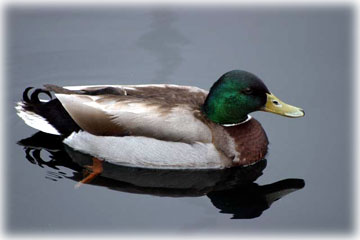 Testing Shows Bird Flu Not
Found in Alaska in 2006
Testing Shows Bird Flu Not
Found in Alaska in 2006
January 09, 2007
Tuesday
(SitNews) - Wildlife officials in Alaska are reviewing data gathered
in 2006 on avian influenza in the state. With all the results
from various avian flu sampling efforts having returned from
laboratories, scientists can safely conclude that Asian H5N1
was not found in Alaska in 2006.
 Ketchikan: Ward Lake
Duck
Ketchikan: Ward Lake
Duck
File Photo by Lisa Thompson
|
At the beginning of 2006, scientists
were concerned that a highly pathogenic strain of bird flu, known
as Asian H5N1, might show up first in wild birds in Alaska and
then spread into the rest of North America. Because Alaska is
considered an avian crossroads where migratory birds from several
continents mix, the state was thought to be a likely entry point
for the disease into North America. State and federal wildlife
managers made plans to sample wild birds and prepare possible
responses should Asian H5N1 turn up in Alaska.
"Roughly 21,000 wild birds
in Alaska were sampled for avian flu by federal and state agencies
last year," said Tom Rothe, waterfowl coordinator with the
Alaska Department of Fish and Game (ADF&G). "That number
exceeded state and federal goals to sample 15,000 to 20,000 birds
from the 26 target species we consider likely carriers of Asian
H5N1 because of their migratory patterns, association with outbreak
areas in Asia, or other factors," he said.
No cases of Asian H5N1 were found in the Alaska samples, Rothe
reported. However, as expected, other low pathogenic forms of
avian flu did turn up in the wild birds sampled. Of the samples
collected by ADF&G, about 7 percent tested positive for some
sort of low-pathogenic avian influenza. "That was about
what we expected," Rothe said. "Waterfowl are known
to naturally harbor various types of low-pathogenic avian influenza
throughout the year."
ADF&G assisted the U.S. Fish and Wildlife Service and the
U.S. Department of Agriculture with the sampling, contributing
about 1,600 of the 21,000 samples from Alaska. Rothe said ADF&G
augmented federal sampling efforts by expanding sampling at existing
bird-banding camps. ADF&G annually captures and bands ducks
at camps at the Susitna Flats near Anchorage and the Minto Flats
near Fairbanks. Sandhill cranes are captured and banded at the
Creamer's Field Migratory Waterfowl Refuge in Fairbanks. "The
largest proportion of the live birds we sampled were northern
pintails and mallards," Rothe said. "The pintails were
one of the primary target species."
In addition to the live birds sampled, ADF&G officials collected
samples from 450 birds shot by hunters at Susitna Flats, Palmer
Hay Flats, and Mendenhall Wetlands State Game Refuges. Half of
these samples were taken from pintails and mallards, but green-winged
teal and wigeon were sampled as well. Waterfowl hunting seasons,
along with the 2006 sampling efforts, will end in late January.
Tom Rothe declared the year's sampling program in Alaska a qualified
success. "Even though thousands of birds were tested, scientists
handled just a small fraction of the millions of wild birds that
congregate in Alaska," he said. "While we're reassured
from our targeted sampling efforts, we can't say with 100 percent
certainty that we're clean."
Biologists from ADF&G and other wildlife agencies are summarizing
results of the 2006 samples and sifting the "lessons learned"
from this unprecedented national disease surveillance effort.
"We expect Fish and Game to sample more birds during 2007,"
Rothe said, "but the extent of our work will depend on a
lot of factors, including global trends in H5N1."
On the Web:
Avian influenza information
and monitoring efforts in Alaska
http://www.avianflu.alaska.gov/
Source of News:
Alaska Department of Fish &
Game
www.adfg.state.ak.us
E-mail your news &
photos to editor@sitnews.us
Publish A Letter on SitNews Read Letters/Opinions
Contact the Editor
SitNews
©2006
Stories In The News
Ketchikan, Alaska
|

